One of the most time-honored methods of art training throughout history has been studying and copying the works of the Masters.
A lot of students have questions about developing their own style in the art of caricature. It’s my belief that your own individual artistic style is mostly a result of your instructors, your artistic influences and, to a lesser extent, the mediums you work in. Today, we’re going to focus on your artistic influences. Now, it’s one thing to just look at art you like and hope it rubs off on you, but it’s another thing entirely to get a pencil or brush out and actually try to make a copy of it. When you make a copy – or a study – of another artist’s caricature, you end up feeling what it’s like to move your hand the same way the original artist did.
When you do it, your muscles and brain will realize what it takes to create that type of exaggeration. It can not only influence your visual style but even improve your skills and decisions when doing your own original work. So if you find an artist or artists whose work you really like and you want to incorporate their strengths into your own, those are the ones you should study.
There are lots of artists I admire and look up to for inspiration – from both the caricature world and the more traditional schools of art. You shouldn’t only look at and do studies of just one artist’s caricatures, or there’s a danger of becoming a clone of that one artist. [Study and copy from several artists] so that you absorb the best qualities of each.
In the premium course, I demonstrate making copies of several artists’ caricatures. But in this main lesson, I will be studying a painting done by the original Karikatur Kaiser, the Grand Master himself, Sebastian Krüger!
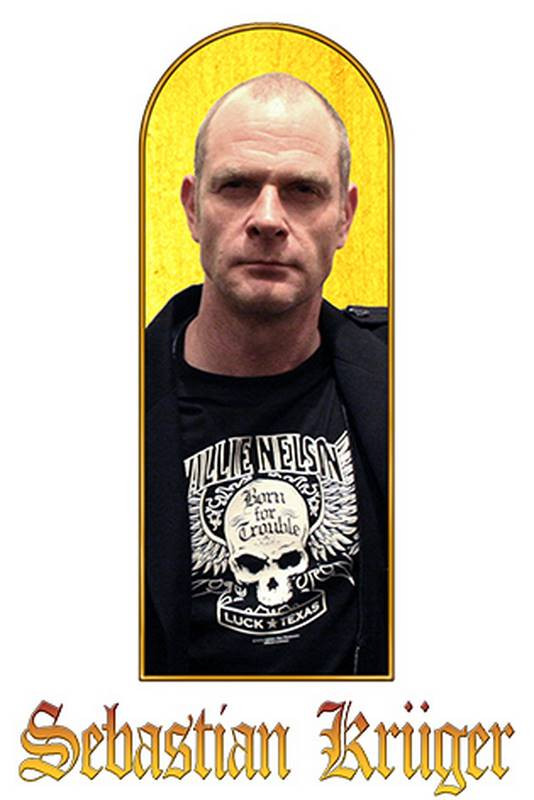

Let's Steal Some Mojo
Above is a painting Krüger did in his 2006 workshop of Romantic Era composer [Richard Wagner]. And here’s the photo that Krüger used when he created this piece. I won’t be referring to the photo while I do my study. But I thought it would be good to see so that you know what Wagner looks like. Krüger’s original is done in acrylics on canvas. But I’ll be doing my study with charcoal pencils on smooth newsprint. Because I’m just interested in learning how he constructs his head shapes and makes his exaggeration choices, not his painting techniques.
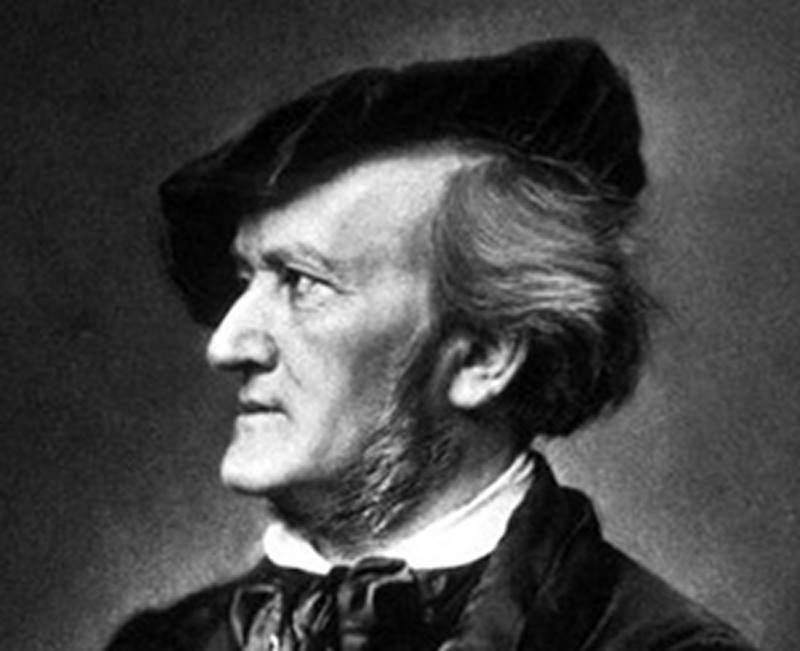
I begin by finding the biggest shapes first, which is the silhouette of the head and hat. I don’t draw the exact outlines, but a simple abstract shape that encompasses the entire subject without any details. Keeping it to this level of simplicity makes it easier for me to judge the overall height and width of the original. Once that is in place, I start dividing it up by finding the next biggest shapes of the hat, hair and profile. Remember, starting with big blocky abstract shapes first is the best way to make sure the proportions will be accurate without spending time working on any details. And accuracy is everything in a master’s study. You don’t want to distort or exaggerate the shapes further. You’re doing master studies to understand their drawing choices.

Now, I divide up the inside shapes like the hair, jawline, and collar, which are the next biggest shapes. In your own drawings, I hope you take the same approach of blocking in the biggest shapes first and then working your way down to smaller and smaller shapes and forms. To make an accurate copy, or to draw anything accurately, it helps to have a process – an order in which you do things. Don’t just jump around different areas of the face, drawing elements randomly. As you continue, you will be able to accurately measure and place more of the features.
If you draw the big shapes first you can better judge the relative proportions, like how tall is the head compared to its width? How far is the eye from the hat? How does the tip of the nose relate to the tip of the chin? And so on. At this point, the facial features are all lightly indicated. So I move on to mapping out the plane changes such as the side of the nose and cheek. These are the areas where I will darken with different levels of value. But I refrain from shading in the drawing until I have the different facets of the face mapped out so that I don’t shade an area and then have to erase it later because it’s in the wrong spot. This is part of my technical process I mentioned earlier. I like to design the areas where the value will go before I start to actually add the value. Krüger is amazing at shape design. Almost every shadow and every halftone has a deliberate and attractive-looking design. Some areas of his painting are shaded with smooth soft transitions from light to dark, but there are other areas which are more outlined and obvious and are part of what make his visual style so distinctive from anyone else.

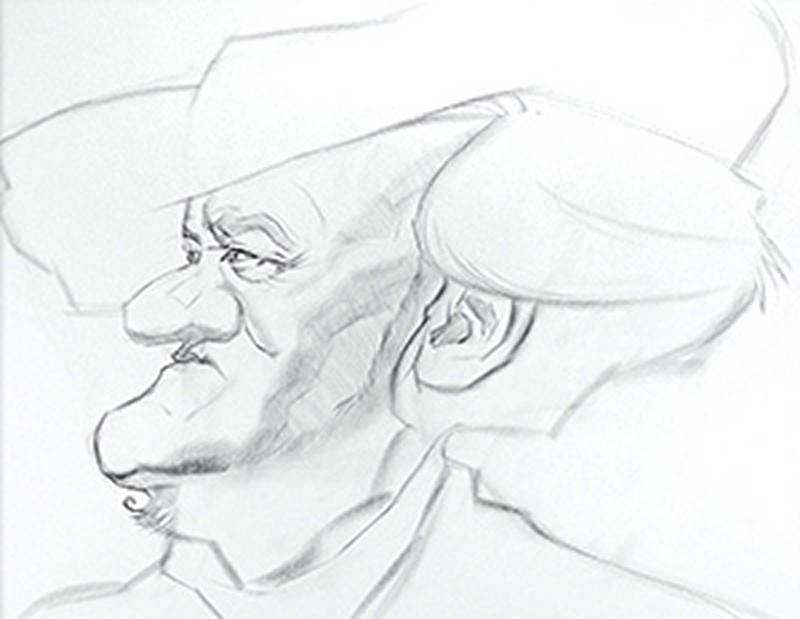
And now, fairly confident that my outer contours and inner shapes of the face are accurate, I finally commit to those decisions with darker lines. As I darken my lines, I’m thinking more consciously about my calligraphy, or the quality of my lines. Some lines are thin and crisp while some are soft and more diffuse. Krüger’s painting is my constant point of reference for those decisions. His painting is in color, but I have to ignore the colors and just focus on the values of those colors and the edges between his shapes.
Now that I’ve darkened most of the important lines in the face, I finally can really get into the rendering and shading. Everything before this has been about setting up the linear aspect of the design. I had to be patient and not jump into trying to get a finished look too soon. But now, after all of that preparatory work, I start to add some cast shadows to the face. This is when the forms will start to pop of the paper and feel more three dimensional. It’s a gratifying feeling because it feels like my reward for making it through the more stressful step of copying the lines.
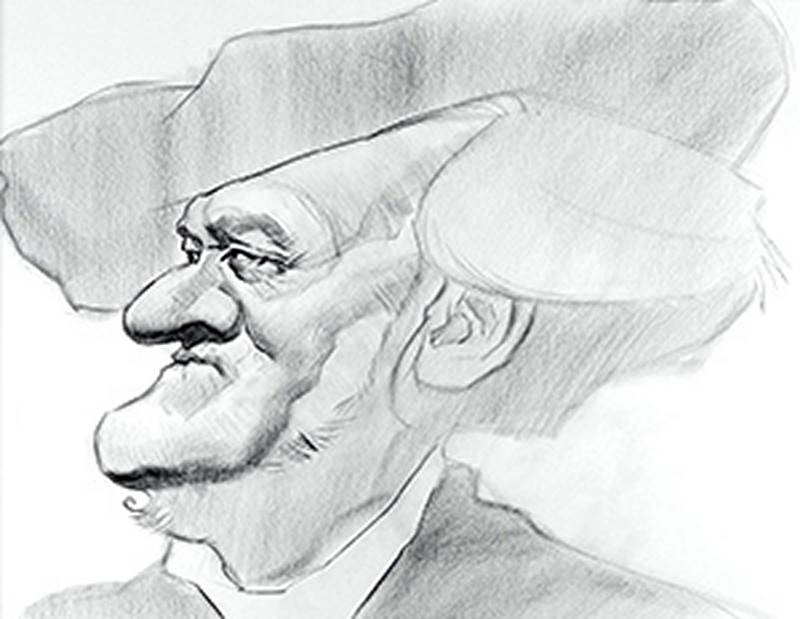
However, I still have to keep focused on what I’m doing and not get ahead of myself, because [the values] need to be judged and placed accurately. As general rule, when working in charcoal, like I am now, I like to build up to my darkest darks. If I go too dark too soon, it’s really hard to erase an area with heavy charcoal applied if I need to show some reflected light in the shadow area, for instance. It’s easier to show reflected light in the shadows, like on the back of Wagner’s neck, if I keep that value a bit lighter initially, then add the darkest darks in the areas around it. If it’s still too light, I can always darken it with another pass of the charcoal pencil. But it’s much harder to lighten it with the eraser if I decide it’s too dark later on. If pressing too hard, the eraser creates a smudged area and damages the grain of the paper so that it looks different from the rest of the drawing.
Creating the texture of the hair and beard is a little tricky. It requires a bit more patience than the rest of the forms because it involves leaving some thin strands lighter while darkening others. And at the same time, I try to keep an eye on the overall effect of the values. Don’t fall into the trap of rendering each individual hair at the expense of the big picture. If an area of hair is in the shadow, all of that hair must stay below a certain dark value. I find it’s helpful to stay leaned back in my chair, far away from the drawing while working on details. Our instinct is to move in close. But that can make you myopic, which means that you focus on the tiny thing at the center of your vision, while ignoring everything around it.

This exercise of copying the caricature of someone else is interesting in that I’m not actually caricaturing anything. I’m not using my caricature skill set. And I’m not using the same process Krüger used when he originally drew it. Based on photos I’ve seen from the workshop, it looks like he loosely and quickly scribbled the drawing on the canvas, much like how I would draw a thumbnail sketch. But remarkably, Krüger went directly from his thumbnail sketch to his finished painting. And that’s good to know if you want to draw your own caricatures more like Krüger. But for this demonstration, I’m trying to draw an exact copy of what I see. So this is actually closer to how I draw a realistic portrait than how I draw a caricature because I’m focused on accuracy and measuring distances rather than changing what I see. And since my caricature muscles are relaxed for this exercise, I’m able to appreciate Krüger’s caricature from a technical standpoint as I draw it. It’s like I’m sitting in the backseat of Krüger’s brain, while he does all the driving, and hopefully gaining confidence to be as free and brave with the shapes of the face as he is.
As I approach the end of this exercise, I can see areas where I distorted the shapes and proportions just a little bit.
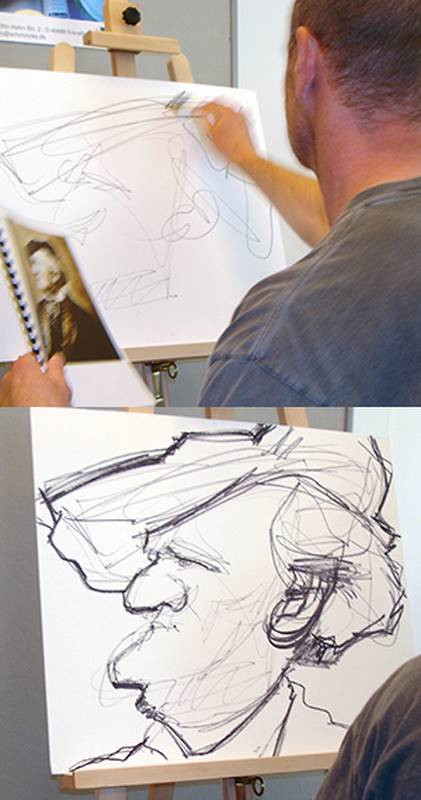
And of course not every line and strand of hair is in the same place. But that’s going to happen. And it’s okay. We’re not trying to create an exact forgery here. The point of this lesson is not to be a copying machine, but to try to capture the spirit and quality of the original artist’s work so that you can understand what the artist did and even perhaps take some of what you learned into your own caricature work.
On a side note, Krüger doesn’t do as much fine art caricature as he used to. He does large scale pop-culture portraits. Some of it is still slightly caricatured. But not to the degree he did in the 90s and early 2000s. Regardless of whether it’s caricature or portrait, Krüger’s work is a wonder to see in person.
And he still runs yearly caricature workshops every fall in Germany you can attend called the Krüger Masterclass. This painting of Wagner was actually done as a live demo in one of his previous Masterclass workshops. To check out his work and find out about his workshop, visit his Instagram.
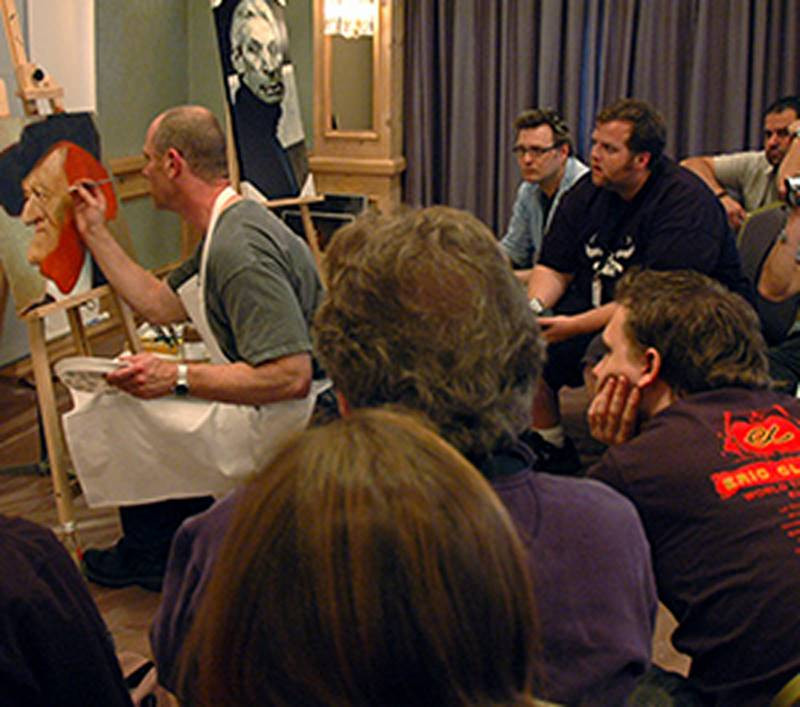
Premium Content
In the Premium Version of this course, you can watch several more videos where I do studies of other Master Caricature Artists’ works, including Jan Opdebeeck, David O’Keefe and others, all while explaining my own thoughts on the process. Get access to lots more example videos, longer versions of the lessons and other bonus content when you purchase the Premium Caricature Course.
Assignments
Your assignment is to choose a caricature by another artist you admire and do a study of it, focusing on copying the shapes and values as best you can. It’s not important to use the same materials the artist did. If the original is a painting or a sculpture, you can still use pencil or charcoal to do the study. The important takeaway from this exercise is in [studying how that artist exaggerated] his or her shapes and to a lesser extent, how they rendered the forms. And if you are able to find the original photo reference they used, that can help give you some additional perspective into the artist’s decisions as well.
After you have completed your study of another artist’s work, do an original caricature in the style of that artist, utilizing the exaggeration choices you learned from the initial study.










